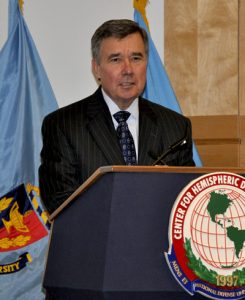
 On May 21, the Center for Hemispheric Defense Studies (CHDS) co-hosted a one-day conference with the Office of National Drug Control Policy, headed by Director R. Gil Kerlikowske, on “Countering Illicit Trafficking Activities in the Western Hemisphere: Possible Strategies and Lessons Learned.” The invitation-only event brought together US Government and Congressional leaders as well as academic subject-matter experts from the United States and elsewhere. The objective was to present ideas and concepts that could serve as key elements of a hemispheric strategy to counter narcotics and Illicit Trafficking Activities (CITA), running from the trafficking in humans as well as arms, to the black market for goods and services.
On May 21, the Center for Hemispheric Defense Studies (CHDS) co-hosted a one-day conference with the Office of National Drug Control Policy, headed by Director R. Gil Kerlikowske, on “Countering Illicit Trafficking Activities in the Western Hemisphere: Possible Strategies and Lessons Learned.” The invitation-only event brought together US Government and Congressional leaders as well as academic subject-matter experts from the United States and elsewhere. The objective was to present ideas and concepts that could serve as key elements of a hemispheric strategy to counter narcotics and Illicit Trafficking Activities (CITA), running from the trafficking in humans as well as arms, to the black market for goods and services.
Kerlikowske, the sixth US “Drug Czar” and a 37-year veteran of law enforcement and drug policy, came to this nation’s capital after serving 9 years as the Chief of Police for Seattle, Washington. When he left that other Washington, crime was at its lowest point in 40 years. During a recess between sessions, Kerlikowske talked with Martin Edwin Andersen, CHDS chief of strategic communications, about several key issues facing his office. Here is part of their conversation:
MEA: Mr. Kerlikowske, every change in Presidential Administration in the United States is accompanied both by change and by continuity. How is drug policy different under President Obama, and what aspects, if any, of continuity do you also see?
Kerlikowske: I think there is a lot of continuity, and that is the fact of the President’s recognition that law enforcement needs strong support and that law enforcement is a big part of any drug strategy.
The differences in his strategy are an emphasis in focus on making prevention and treatment as important as the law enforcement and interdiction part have been. And also, just the clear recognition that by addressing the problem in a more balanced way we actually have the potential to make more headway.
MEA: The Mexican President was just here in Washington this week. What are the most important takeaways you see as resulting from his meeting with President Obama and other leaders here?
Kerlikowske: I think President Calderon’s meeting was a strong showing of the partnership and the relationship between the two countries and the fact that, as Secretary Clinton has mentioned, this is a shared responsibility. The partnership that exists not only in interdiction and law enforcement but the fact that the United States has been able to work with Mexico to help them open up their first drug court, to do more community organizing and building. And the fact that the President’s wife, Margarita Zavala, has made prevention and treatment a signature issue, which she showed the President Obama’s wife, Michelle, when she visited there just last month.
MEA: Do you see a link between effective drug policy and comprehensive immigration reform and, if so, what factors are involved?
Kerlikowske: Well, I do. Immigration is not really my subject matter, but I think that President Obama has made some very clear statements that the federal responsibility to have a comprehensive immigration should be fulfilled and that a comprehensive immigration law would be helpful in reducing not just the problems of drug trafficking, but certainly human trafficking also.
MEA: If your office was magically given an additional $10 billion to fight the drug scourage in the United States, how would you spend it, and why?
Kerlikowske: I’d spend it on prevention and treatment. I think law enforcement and interdiction need strong support, and we’ve continued to do that. We just really have not put the resources into prevention and treatment that we should.
CONTACT INFORMATION